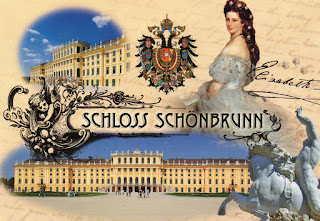This palace and its gardens are the kind of place that makes us travel in time!
 |
| Schönbrunn Palace |
This postcard was given to me by my cousin Andreia
Schönbrunn Palace (German: Schloss Schönbrunn) is a former imperial summer residence located in Vienna, Austria. The 1,441-room Baroque palace is one of the most important architectural, cultural and historical monuments in the country. Since the mid-1950s it has been a major tourist attraction.
The history of the palace and its vast gardens spans over 300 years, reflecting the changing tastes, interests, and aspirations of successive Habsburg monarchs. - in: wikipedia
 |
| Schönbrunn Palace and the Gloriette |
This postcard was sent by Danubia
The largest and probably most well-known gloriette is in the Schönbrunn Palace Garden in Vienna. Built in 1775 as the last building constructed in the garden according to the plans of Austrian imperial architect Johann Ferdinand Hetzendorf von Hohenberg as a "temple of renown" to serve as both a focal point and a lookout point for the garden, it was used as a dining hall and festival hall as well as a breakfast room for emperor Franz Joseph I. The dining hall, which was used up until the end of the monarchy, today has a café in it, and on the roof an observation platform overlooks Vienna. The Gloriette's decorative sculptures were made by the famous Salzburg sculptorJohann Baptist von Hagenauer. The Gloriette was destroyed in the Second World War, but had already been restored by 1947, and was restored again in 1995 - in: wikipedia
 |
| Schönbrunn Palace and Empress Elisabeth portrait |
This postcard was sent by Friedrich
The Sisi Museum in the Vienna Hofburg, Schönbrunn Palace and the Imperial Furniture Collection provide authentic insights into the life and personality of this famous monarch.
In 2004 the Sisi Museum opened in a section of the Imperial Apartments once occupied by the empress. With more than 300 personal objects on display, the exhibition avoids the usual clichés, presenting Elisabeth’s true personality in a sensitive exploration of the empress’s life and fate. Elisabeth’s verse is used to illustrate her emotional states of mind at each stage of her life, from her carefree girlhood to the restless, aloof and melancholic woman she later became. - in: http://www.schoenbrunn.at/en/nc/services/press-information/archive/press-information-2011/press-information-detail-2011/artikel/auf-den-spuren-von-kaiserin-elisabeth-in-wien-1.html



No comments:
Post a Comment